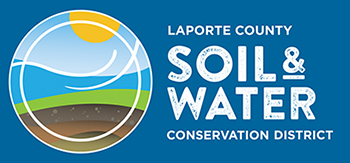
While homeowners do not have regulatory requirements in terms of storm water, even a small plot of land can have an impact on the quality of the water entering our rivers, streams and lakes. The impervious or hard surfaces of rooftops, driveways and patios can contribute polluted run-off. This run-off can pick up pollutants such as oil, pet waste, lawn fertilizers, pesticides and nutrients from grass clippings.
In addition, homeowners that have illicit discharges into storm drains or regulated county drains (ditches) can be causing large problems.
Remember, we all live in a watershed! This means that all of the water that falls as rain will drain into our nearest waterway. Everything we do on the land has an impact on our water quality-the water we use for drinking, bathing, swimming, fishing and recreation!
Do you know about your watershed? You can find more information about the watershed you live in by visiting the EPA’s website, “Surf Your Watershed”. While there, you can enter your zip code and find out which watershed you live in! You will also find useful information such as groups that are working on fixing water quality problems in your area. Click this link:
Best Management Practices for Homeowners
Homeowners are not required by any laws to install best management practices. However, there are many to choose from that will allow the homeowner to conserve water, reduce run-off and increase habitat for insects, birds and mammals.
Find information in the next few pages about best management practices that can be used in a residential setting.
Fertilizing Your Lawn
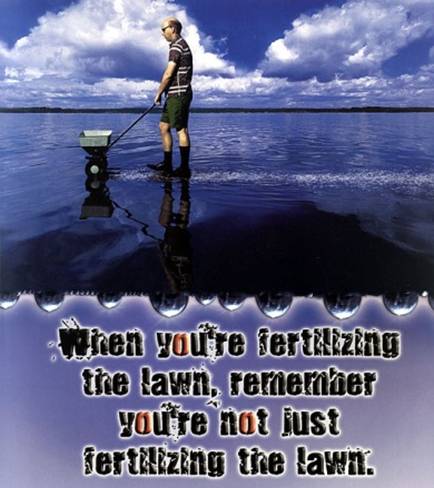
What is the problem with fertilizing your lawn? Nothing, as long as you are applying properly and sparingly. When you don’t, rains can wash excess fertilizer down the storm drains. This excess fertilizer can cause algae blooms and fish kills. Remember, if it makes your grass grow green and lush, it will have the same effects on the algae in the lakes and rivers!
HOW TO PROTECT YOUR WATER FROM FERTILIZER:
- Don’t fertilize before a rainstorm
- Test your soil before applying! Most lawns don’t need as much fertilizer as you may think. Testing allows you to target your inputs and save money.
- Compost! Making your own compost allows you to reduce your solid waste production and provides valuable nutrients and structure to your soil.
- Install buffer strips of vegetation around water ways and ponds. This vegetation will filter and trap excess nutrients.
- Don’t bag your grass! Use a mulching lawn mower and you will leave nutrient rich grass clippings on the lawn.
- When you wash off your equipment, don’t do it on a hard surface. Allow the water (and attached nutrients) to infiltrate naturally by cleaning up on a pervious, vegetated surface such as a lawn or field.
- Install native plants and grasses! These plants are adapted to our local conditions and require less (or none) fertilizer and water . If you need assistance selecting native plants for your application, please contact our office at 219-326-6808, ext. 2115. You can also use this clever native plant selector from Blue Thumb.
Blue Thumb Plant Selector Tool
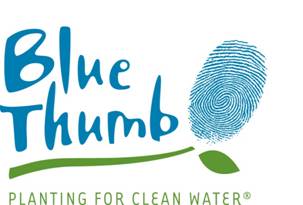
Blue Thumb: Planting for Clean Water
The LaPorte County Soil and Water Conservation District is a Blue Thumb Partner. Blue Thumb is an outreach program that was created by the Rice Creek Minnesota Watershed District to help meet water quality goals. The program now has over 70 partners in several different states! The award-winning Blue Thumb program was featured as the first stop on the Cousteau “Blue Legacy Tour” sponsored by National Geographic.
Blue Thumb encourages people to “plant for clean water”. Why should you plant for clean water? You can click here for a whole host of reasons, but here are some reasons to have a “Blue Thumb”: (from the Blue Thumb Website)
Why Have a Blue Thumb?
- The Problem— The U.S. Environmental Protection Agency has named stormwater runoff as our nation’s biggest water quality threat. Stormwater runoff whisks pollutants from our streets to our lakes and streams via storm drains.
- The Solution— Planting for Clean Water is part of the solution to water pollution because it mimics nature and natural hydrology. In natural landscapes, rain tends to soak into the ground gradually. However, nowadays, much of the land is covered by impervious surfaces – such as streets, parking lots and roofs – where the water cannot soak into the ground. Blue Thumb plantings help infiltrate water back into the ground and stop the stormwater runoff.
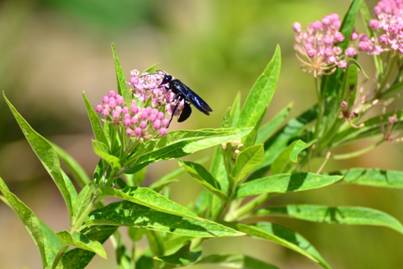
Blue Mud Wasp on Swamp Milkweed
Rain Barrels- Why Harvest Rainwater with Rain Barrels?
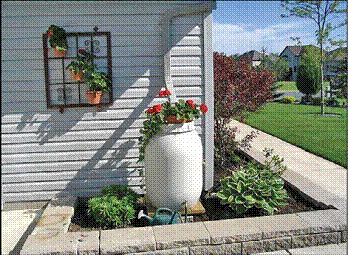
- Helps Reduce Stormwater Pollution-Rainwater stored in rain barrels helps reduce the amount of stormwater runoff and the amount of pollutants that are picked up and carried to storm sewers, creeks and all other water bodies.
- Conserves Water Supply Resources-Rainwater used from rain barrels helps reduce the amount of water used from underground aquifers.
- Better for Plants and Gardens-Rainwater stored in rain barrels is a naturally soft water and devoid of minerals, chlorine, fluoride, and other chemicals. For this reason, plants respond very well to rainwater. After all, it’s what plants in the wild thrive on!
- Helps Inform Your Neighbors -One of the best reasons to start harvesting rainwater with rain barrels is to teach and encourage others to do the same, You will help to spread the culture of rainwater collection and in turn, help your larger community and the environment. It is always important to remember that every living thing on the planet needs water to survive so, we as humans must expand our idea of community to the plants and animals that surround us.
Using Rain Barrel Water
- Water your flowers, trees, shrubs, and lawn
- Wash your car; rinse tools or muddy boots.
- DO NOT DRINK WATER from your rain barrel.
- DO NOT COOK OR BATHE with water from your rain barrel
Rain Gardens – Beautiful and Functional
Stormwater runoff can contain leaves, grass clippings, fertilizers and pesticides from streets and rooftops that are contaminating our lakes and rivers. An easy way to help water infiltrate into the ground rather than run off into storm sewers is by creating a raingarden. It is important to carefully consider the location of the garden. You want it to intercept rain water before it runs off of the site. If constructed properly, the garden will drain the water within two days. (from Blue Thumb website)
What’s a raingarden?
Raingardens are depressional or bowl-shaped gardens that contain native plants that are adapted to tolerate periodic inundation. Between rains, they can tolerate periods of drought. The deep roots of these plants assist with water infiltration. Raingardens can also provide habitat for birds, butterflies and other insects and be a beautiful addition to your landscape. They are easy to install and can be sized to fit any application.
Blue Thumb Tools to Design Your Own Raingarden (from Blue Thumb website)
You can find many helpful tools for your raingarden by clicking here.
The U.S. Environmental Protection Agency (EPA) also has links to many helpful tools. Find them here.
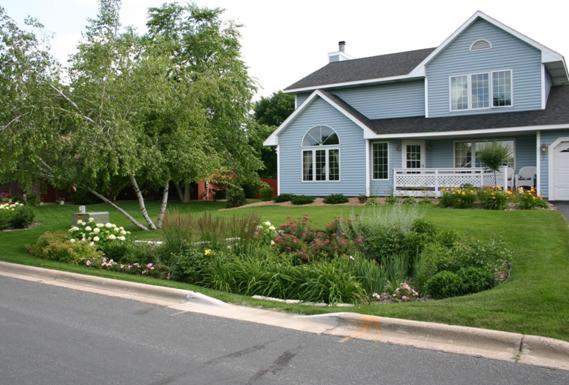
A Residential Raingarden
Source: http://water.epa.gov/infrastructure/greeninfrastructure/gi_what.cfm
Pet Waste
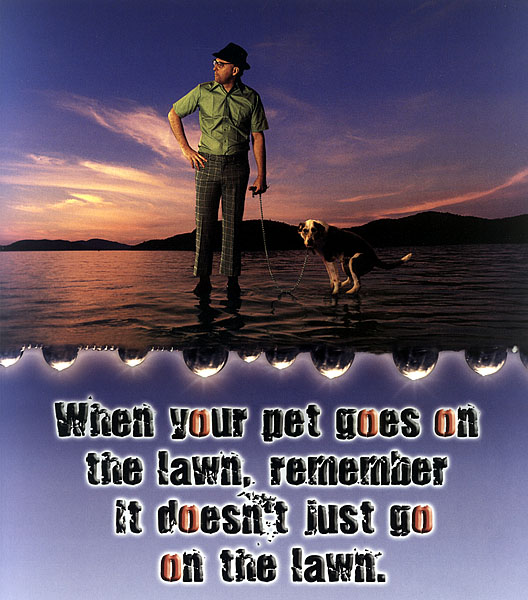
- Be sure to clean up after your pet and dispose of the waste properly-flush down the toilet if you can, as this will ensure that the waste is properly treated
- If unable to flush, wrap and dispose in the garbage
Driveways and Garages
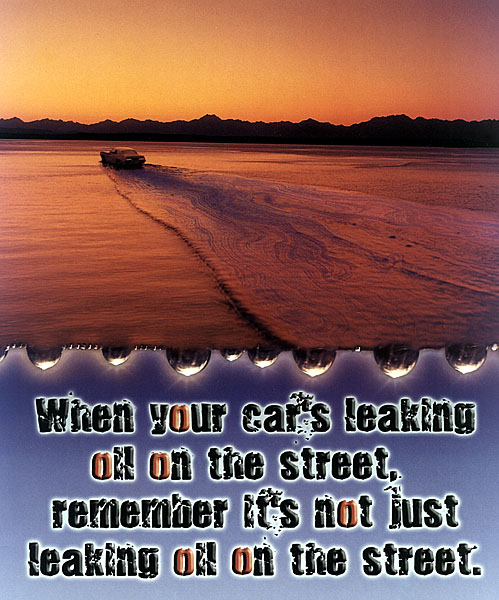
- Check your vehicle for leaks regularly! If you find them, fix them.
- Be sure you clean up spills immediately. Use drop cloths or pans when working on your vehicle in the driveway
- Be sure you store all used oil and other fluids in containers with tight lids
- Don’t mix your used/waste oil with other fluids (gasoline, anti-freeze, etc.) This will contaminate your oil and make it unusable when recycled
- NEVER DUMP USED OIL OR OTHER FLUIDS DOWN A GUTTER, INTO A STORM DRAIN OR IN A DITCH!
- Always recycle used oil properly!
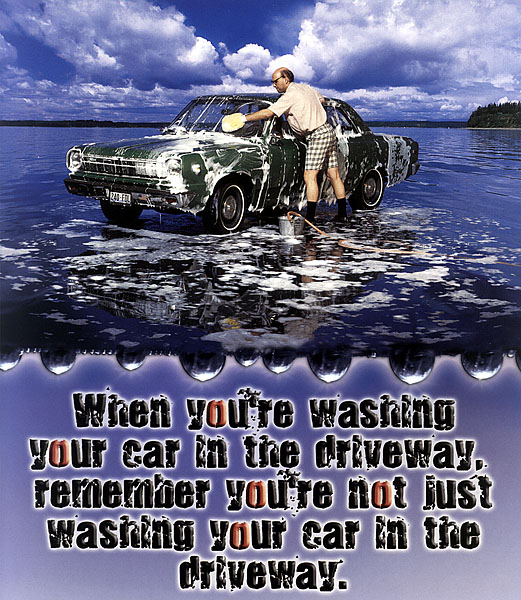
- Never wash your car in the street. Instead, wash it on a grassy or other pervious surface so the water can get filtered by the plants and soil
- Use non-phosphorus soaps and detergents
- Use a hose that is high-pressure and low volume. Make sure it has a nozzle so that you aren’t wasting water!
- Be sure to empty your bucket in the sink, not down the storm drains
- The best place to wash your car is at a commercial car wash. This water will likely get used several times before it is sent to a wastewater treatment plant to be cleaned
- If you are having a car-wash fundraiser, please check with the local Sanitary District or Wastewater Plant. They will be able to help you locate a good spot to hold it.
Maintain Your Septic System
The LaPorte County Health Department is available to advise homeowners on all things related to their on-site septic system. You can find their on-site septic system site here:
LaPorte County Health Department On-Site Septic
The Indiana State Department of Health also has a wealth of information available on their site. You can find it here:
Indiana State Department of Health On-Site Septic
The LaPorte County Purdue Extension also has a valuable publication on this topic. Find it here:
